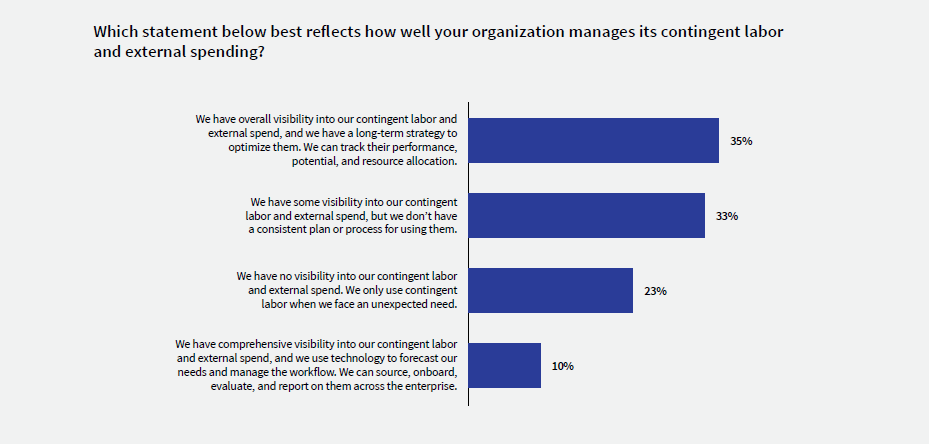4 Steps to Getting Started on Optimizing Your Contingent Workforce
Sam Smith | March 22 2024 |

According to Gartner research, the percentage of contingent labor in the global workforce is predicted to reach 35 to 40 percent by 2025, while Ardent Partners estimates this figure at closer to 50 percent. The growing need for specialized digital skills, coupled with the critical need to organizations to remain flexible amidst changing market conditions, is driving much of this growth.
Given both the increasing demand for and rising numbers of the contingent workforce, organizations more than ever need to effectively and strategically source and manage contingent talent. To stay ahead of unpredictable shifts in the labor market and the war for talent, they must also leverage optimization tools to reduce costs and maximize use. But how many organizations have fully embraced and optimized their contingent workforce?
According to a recent HRO Today survey, only 14% use a comprehensive suite of integrated technologies to manage the contingent labor process. In this blog post we’re going to explore the beginning steps to optimizing contingent workforce management and provide insights on how organizations are currently enhancing it based on data from this survey. (See the complete survey results in the full (white paper.)
1. Determining Talent Management Responsibility
Although procurement teams are skilled at cost management and contract negotiation, a wide range of expertise is necessary for managing contingent labor, which is often better suited for human resources or talent acquisition. Managing the contingent workforce successfully also involves going beyond traditional procurement responsibilities, including:
- Having knowledge on compliance regulations
- Understanding complex labor laws
- Handling talent sourcing
- Managing the human aspect of the workforce
Considering the diverse skills and knowledge necessary to manage the contingent workforce, how are organizations approaching it today? According to the HRO survey, responsibility for procuring contingent labor in organizations has shifted over the years. Two-thirds of respondents (66%) indicated it is now HR’s responsibility, while 20% stated it is a combination of HR and Procurement.
Given their roles, the collaborative efforts between procurement and HR as a strategy will lead to improved efficiency and compliance. As organizations decide which teams to involve in managing this increasingly critical workforce, it is fundamental that they see it as an essential part of their planned workforce instead of just a variable operating expense. (See how partnering with an Employer of Record (EOR) can help you navigate challenging compliance regulations and co-employment risk with confidence.)
2. Assessing Contingent Talent Spend Management
The approach organizations take to manage their contingent labor spend is also critical. According to the HRO survey, over half (56%) of organizations have limited or no visibility into their contingent labor and external spend (see chart below). A lack of visibility into the contingent workforce and external spend can lead to several issues, including:
- Organizational inefficiencies
- Higher workforce costs
- Poor decision-making

On the other hand, by taking a centralized approach to contingent workforce management (CWM), HR leaders can see where and how contingent talent is being used across the organization holistically. This view helps them identify areas for cost savings, business process improvement, and how the contingent workforce fits into the organization’s overall workforce strategy. Learn more about the different ways a streamlined, centralized approach to contingent workforce management can optimize program success.
Additionally, organizations can get a competitive edge by partnering with a Managed Service Provider (MSP) and leveraging a leading-edge vendor management system (VMS), which allows them to track key metrics and compare its use of contingent talent to its competitors. Find out more about the various advantages of utilizing an MSP in our blog.
3. Planning for Contingent Talent Needs
The way organizations are planning around their current and future contingent workforce needs is also key to consider. According to the HRO survey, most organizations (55%) plan for contingent talent in a reactive fashion to an imminent or immediate need. This leaves less than one in five (18%) organizations with a comprehensive view into their contingent workforce, utilizing talent mapping, forecasting, as well as redeployment and exit plans.
Organizations that are looking to strategically plan their workforce needs for the future should include the following steps:
- Collect data on the current contingent workforce, including roles, skills, costs, performance, compliance status and contracts.
- Identify gaps and risks within the current workforce strategy, such as talent pipeline issues, skills shortages, or relevant regulatory shifts.
- Define the metrics and objectives for the contingent workforce and align them with the overall business goals and strategy.
- Create supply and demand forecasts for the contingent workforce, including estimates of the type and number of contingent workers necessary short-term and long-term based on metrics, objectives and up-to-date market trends. (Download our report for insights on the latest developments in the labor market.)
As the final step of the process, program owners should carefully track the results of the plan, frequently measuring against expectations and benchmarks so they can adjust accordingly as needed to reach their goals. Planning for future needs ahead of time is a crucial component to optimizing program efficiency and overall workforce planning success.
4. Sourcing Contingent Labor
With the amount of talent sourcing approaches available, organizations have various options. According to the HRO Today survey, 48% typically use a list of preferred MSPs to recruit contingent talent, although hiring managers sometimes rely on their own network as well. The supplier network can be combined with an organization’s direct sourcing program to amplify sourcing efforts, which is an advantageous strategy, especially in a tight labor market – yet less than one-third of survey respondents (32%) are doing so.
The benefits of joining these efforts to find talent include not only cost savings but accelerated time to fill and a high level of talent, since the organization is sourcing from known candidates. But doing so effectively requires a combination of real-time data and intelligence, AI-driven matching technology and expert curation services. For more on how you can overcome common challenges and realize the benefits of expanded talent access, check out our resources on how leading-edge MSPs are playing a strategic role in talent acquisition and how you can build a successful direct sourcing program in your organization.
Progressing Toward Making Optimization a Reality
As the contingent workforce continues to grow in size and importance to organizations, they must find solutions, partners and technologies to help them overcome rising challenges and complexities to remain nimble and stand out among competitors. But before starting the journey, organizations need to start viewing their contingent workforce as not just a short-term workforce supplement but a valuable component of at total workforce solution strategy.
Learn more about enhancing management visibility into the contingent workforce and best practices for talent acquisition in a dynamic labor market when you download the white paper, “Optimizing Contingent Labor: Key Struggles and Opportunities.”
Disclaimer: The content in this blog post is for informational purposes only and cannot be construed as specific legal advice or as a substitute for legal advice. The blog post reflects the opinion of Magnit and is not to be construed as legal solutions and positions. Contact an attorney for specific advice and guidance for specific issues or questions.
